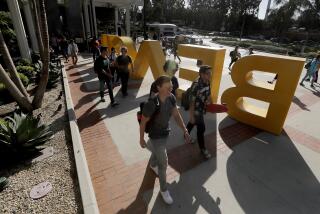CSUF Restores 133 Fall Classes It Axed Earlier
- Share via
Gambling that enough state funds will come its way, Cal State Fullerton is restoring 133 of about 300 classes that were to be eliminated this fall. Many will be general-education-requirement courses that are in greatest demand but shortest supply for the coming semester.
“This is fantastic because it helps us serve the students here better,” said Don Schweitzer, Fullerton’s vice president of academic affairs. The extra classes will allow the university to serve the equivalent of another 600 full-time students.
The added classes are made possible because Cal State University Chancellor Barry Munitz announced Thursday that he would release $15.4 million to CSU campuses in an effort to restore 3,700 of about 5,000 classes statewide that previously had been canceled for the fall. Munitz said that in releasing the money, he is betting the state budget will not cut so deeply into the university system.
In announcing the $15.4-million worth of restorations, Cal State Chancellor Barry Munitz also said layoffs would be rescinded for about 1,000 professors and instructors. That accounts for two-thirds of those who received notices, the vast majority of whom are part-time teachers.
Cal State Fullerton has issued layoff notices to 34 employees, including eight faculty members. Schweitzer said the extra $571,435 coming to Fullerton may make it possible to call back those eight instructors.
But Munitz warned that if state funds turn out to be less than expected, students and teachers will face “nightmarish” class cuts next spring to make up the difference.
“It makes me extraordinarily apprehensive about the spring,” he said, explaining that he was taking the risk because of promising developments on budget proposals in Sacramento.
Munitz denied that he was using the class restorations as a pressure tactic on Gov. Pete Wilson and the Legislature, who remain deadlocked on a budget more than a month after it was supposed to be completed. With students registering for the fall session, the chancellor said he could no longer delay decisions about course offerings.
“My major concern is not the public perception but meeting the student demand for this fall,” Munitz said, speaking to reporters in a telephone news conference.
However, there are indications that publicity about cuts has scared away thousands of potential students. At San Diego State, a bitter controversy about faculty layoffs and proposed departmental closings has caused registration to drop so sharply, officials say, that the campus is not eligible for any of the $15.4 million in restoration funds.
Officials said the equivalent of 270,000 full-time students attended the 20 Cal State campuses last fall. They feared that the announced cutbacks for the fall would have reduced enrollment in the system to about 241,000. Thursday’s announcement, they hope, will help attract the equivalent of 255,000 full-time students.
Munitz said several actions in Sacramento prompted him to make the extra funds available to campuses.
First, the Legislature’s Conference Committee recently agreed on a 6.5%, or $109 million, cut in Cal State’s basic support budget, a trim that hurts but is not devastating. Both the governor and Legislature now support the 40% fee hike Cal State leaders want, an increase that will bring annual fees to $1,308 for in-state students, excluding room and board. Wilson recently signed into law an early retirement incentive for Cal State faculty that is expected to save money and lessen layoffs.
Patrick Nichelson, president of the systemwide faculty union, said he strongly supports Munitz’s move. “What he’s basically trying to do is tell the governor and Legislature that the budget the Conference Committee came up with is terrible but we can live with it,” Nichelson said. “What I think he’s trying to do is send a very strong signal that we just can’t do with anything deeper.”
However, student leaders and a key legislator had less enthusiastic responses.
Jeff Chang, legislative director for the systemwide Cal State Student Assn., said the restorations would be only a small help. Many students are being driven away by the fee increase and by uncertainty about financial aid spawned by the budget stalemate, Chang said. “Overall, it’s pretty gloomy. You can’t help but be depressed,” he said.
Tom Hayden, the Santa Monica Democrat who is chairman of the Assembly’s Higher Education Committee, said about 10,000 Cal State course sections were dropped in 1991-92 and 1,300 more will be cut this fall, even with Thursday’s restorations.
“For the average CSU students, it’s still a net loss,” Hayden said. But he described Munitz’s action as “good leadership” in bargaining with the Legislature and governor to obtain the fee increase and early retirement plan.
Except for San Diego and the new, small San Marcos campus, all the other 18 Cal States will receive some of the extra funds. In Southern California, there are 74 classes to be restored at Bakersfield, 282 at Dominguez Hills, 170 at Long Beach, 146 at Los Angeles, 100 at Northridge, 131 at Pomona and 169 at San Bernardino.
Cal State Fullerton had planned to offer about 300 fewer classes than the 3,050 given last fall. That left many of the university’s 25,000 or so students unable to get what they need.
“When we look at our initial . . . registration requests, we had a list of courses where the demand was more than 70% greater than available seats,” Vice President Schweitzer said.
He said they began restoring 133 of those courses late last week, anticipating that Munitz would agree to their funding request. Most of the added classes are key courses in humanities, communication and social sciences that are requirements for many degree programs.
“We simply ran the risk,” Schweitzer said. “We figured that if there was no money after all, we would simply make it up in the spring of 1993.”
Staff writer David Smollar in San Diego contributed to this story.
More to Read
Sign up for Essential California
The most important California stories and recommendations in your inbox every morning.
You may occasionally receive promotional content from the Los Angeles Times.











